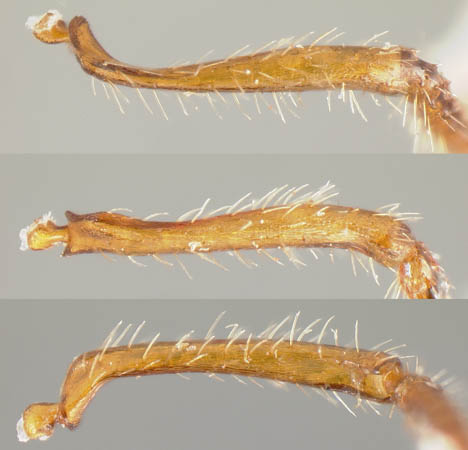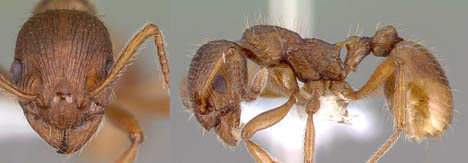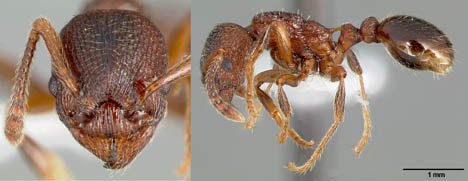
Myrmica specioides scape
Myrmicinae, Formicidae, Hymenoptera, Insecta, Arthropoda, Animalia

Wetterer, J. A., and A. G. Radchenko 2010. Worldwide spread of the ruby ant, Myrmica rubra (Hymenoptera: Formicidae). Myrmecological News 14:87-96. (journal link).
Range
Widespread in Europe, introduced in northeastern North America, and recently arrived in northwestern North America, around Puget Sound.
Identification
Species of Myrmica often vary in the shape of the scape. The scape is the first antennal segment of ants, which is longer than all the others and separated from the remaining segments by an elbow. The base of the scape, near the attachment to the head, may be evenly curved and round in cross section. Alternatively, the base may be somewhat flattened, and/or with a ridge or flange that can make the scape look more abrubptly bent at the base. In the following three figures, the scapes of three species are shown in standard views. Each figure shows three views of the scape rotated around the long axis, with the base of the scape to the left. The upper view shows maximum curvature of the base from the "outer" side of the scape, away from the bend of the elbow. The lower view shows maximum curvature but from the inner side of the elbow. The middle view shows the side of the scape with the curvature pointed away from the viewer.
The figure below is of M. specioides. The base of the scape is somewhat flattened and there is a weak ridge or flange, so that the base looks abruptly bent. Most of the native Myrmica in the Puget Sound region have a flange at the base, often even more developed than on M. specioides.
The native species M. incompleta and the introduced species M. rubra have the scape base evenly curved, with no trace of a flange. The figure below shows the scape of M. incompleta. Relative to M. rubra, it is somewhat more robust, thicker relative to the length, and with the base slightly flattened.
The figure below is the scape of M. rubra. Relative to M. incompleta, the scape is thinner relative to length, and the base is nearly round in cross section, not at all flattened.
The following three figures show face and lateral views of M. specioides, M. incompleta, and M. rubra. Myrmica specioides is usually light orange brown. Myrmica incompleta is dark red brown to nearly black. Myrmica rubra is in between, an intermediate red brown.

Myrmica specioides habitus. Images courtesy of AntWeb, http://www.antweb.org/bigPicture.do?name=casent0172726&shot=h&number=1, http://www.antweb.org/bigPicture.do?name=casent0172726&shot=p&number=1.

Myrmica incompleta habitus. Images courtesy of AntWeb, http://www.antweb.org/bigPicture.do?name=casent0005703&shot=h&number=1, http://www.antweb.org/bigPicture.do?name=casent0005703&shot=p&number=1.

Myrmica rubra habitus. Images courtesy of AntWeb, http://www.antweb.org/bigPicture.do?name=casent0010684&shot=h&number=1, http://www.antweb.org/bigPicture.do?name=casent0010684&shot=p&number=1.
Myrmica rubra has an overall shinier look than M. incompleta. The figure below shows the upper face of M. incompleta (top) and M. rubra (bottom). The spaces in between the ridges are smoother on M. rubra.

In the field, the native species and M. specioides are barely noticeable. They have small colonies and workers occur sparsely on the ground. They are timid and almost never sting. They are definitely beneath the average person's radar. In contrast, M. rubra is a noticeable pest. Colonies can be very large with high densities of workers. The workers can be aggressive and will attack and sting. There are accounts of recreational boaters being driven away from shore by ants swarming onto their canoe and stinging.
Comments
I received from Laurel Hansen specimens of Myrmica rubra that were collected in 2006 from Victoria, B.C., and specimens that were collected in Seattle, in the University of Washington area, in 2006. Collections by Laurel Hansen and Jenni Cena in June and July 2010 have confirmed a thriving population on Foster Island near the University of Washington Campus.
A recent message from Robert Higgins (Thompson Rivers University, B.C.) states "I have gathered a bit of information relating to the M. rubra that were sent to you from Canada in 2006. If my sources are correct, Laurel Hansen passed them along to you. They were labelled only "June 2006; Victoria BC." The location, however, may be incorrect. The specimens given to Laurel came from Bob Lucy (provincial pesticide licencing officer). He received them from a homeowner, but he now thinks that homeowner lived in Richmond, BC (Richmond is part of greater Vancouver). It is possible he labelled them as coming from Victoria simply because that is where he lives."
Some websites with information on Myrmica rubra in the eastern U.S.:
http://entnemdept.ufl.edu/creatures/urban/ants/Myrmica_ruba.htm
http://www.myrmecos.net/myrmicinae/MyrRub1.html
http://www.wabi.tv/news/13074/researchers-try-to-squash-fire-ant-population
Page author:
John T. Longino, The Evergreen State College, Olympia WA 98505 USA. longinoj@evergreen.edu